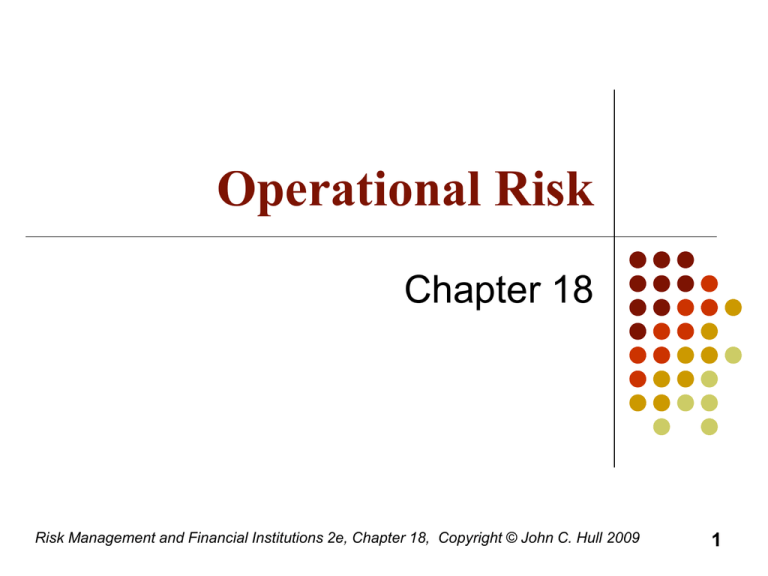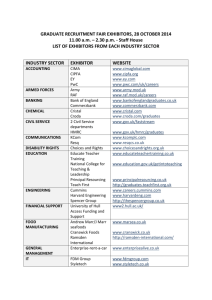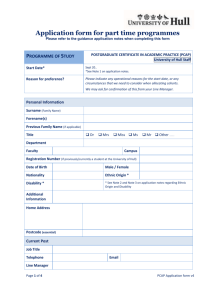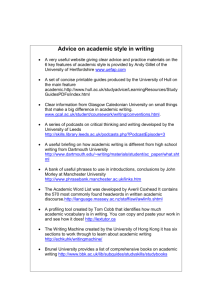1 Risk Management and Financial Institutions 2e, Chapter 18
advertisement

Operational Risk Chapter 18 Risk Management and Financial Institutions 2e, Chapter 18, Copyright © John C. Hull 2009 1 Definition of Operational Risk “Operational risk is the risk of loss resulting from inadequate or failed internal processes, people, and systems, or from external events” Basel Committee Jan 2001 Risk Management and Financial Institutions 2e, Chapter 18, Copyright © John C. Hull 2009 2 What It Includes The definition includes people risks, technology and processing risks, physical risks, legal risks, etc The definition excludes reputation risk and strategic risk Risk Management and Financial Institutions 2e, Chapter 18, Copyright © John C. Hull 2009 3 Regulatory Capital (page 369) In Basel II there is a capital charge for Operational Risk Three alternatives: Basic Indicator (15% of annual gross income) Standardized (different percentage for each business line) Advanced Measurement Approach (AMA) Risk Management and Financial Institutions 2e, Chapter 18, Copyright © John C. Hull 2009 4 Categorization of Business Lines Corporate finance Trading and sales Retail banking Commercial banking Payment and settlement Agency services Asset management Retail brokerage Risk Management and Financial Institutions 2e, Chapter 18, Copyright © John C. Hull 2009 5 Categorization of risks Internal fraud External fraud Employment practices and workplace safety Clients, products and business practices Damage to physical assets Business disruption and system failures Execution, delivery and process management Risk Management and Financial Institutions 2e, Chapter 18, Copyright © John C. Hull 2009 6 The Task Under AMA Banks need to estimate their exposure to each combination of type of risk and business line Ideally this will lead to 7×8=56 VaR measures that can be combined into an overall VaR measure (Chapter 21 will discuss how this can be) Risk Management and Financial Institutions 2e, Chapter 18, Copyright © John C. Hull 2009 7 Loss Severity vs Loss Frequency (page 371) Loss frequency should be estimated from the banks own data as far as possible. One possibility is to assume a Poisson distribution so that we need only estimate an average loss frequency. Probability of n events in time T is then e T ( T ) n n! Loss severity can be based on internal and external historical data. (One possibility is to assume a lognormal distribution so that we need only estimate the mean and SD of losses) Risk Management and Financial Institutions 2e, Chapter 18, Copyright © John C. Hull 2009 8 Using Monte Carlo to combine the Distributions (Figure 18.2) Risk Management and Financial Institutions 2e, Chapter 18, Copyright © John C. Hull 2009 9 Monte Carlo Simulation Trial (page 372) Sample from frequency distribution to determine the number of loss events (=n) Sample n times from the loss severity distribution to determine the loss severity for each loss event Sum loss severities to determine total loss Risk Management and Financial Institutions 2e, Chapter 18, Copyright © John C. Hull 2009 10 External Historical Loss Severity Data Two possibilities data sharing data vendors Data from vendors is based on publicly available information and therefore is biased towards large losses Data from vendors can therefore only be used to estimate the relative size of the mean losses and SD of losses for different risk categories Risk Management and Financial Institutions 2e, Chapter 18, Copyright © John C. Hull 2009 11 Scaling for Size (page 374) Estimated Loss for Bank A Bank A Revenue Observed Loss for Bank B Bank B Revenue Using external data, Shih et al estimate 0.23 Risk Management and Financial Institutions 2e, Chapter 18, Copyright © John C. Hull 2009 12 Other Techniques Scenario Analysis Identifying Causal Relationships RCSA KRI Scorecard approaches The power law Risk Management and Financial Institutions 2e, Chapter 18, Copyright © John C. Hull 2009 13 Insurance (page 378-79) Factors that affect the design of an insurance contract Moral hazard Adverse selection To take account of these factors there are deductibles co-insurance provisions policy limits Risk Management and Financial Institutions 2e, Chapter 18, Copyright © John C. Hull 2009 14 Sarbanes-Oxley (page 379) CEO and CFO are more accountable SEC has more powers Auditors are not allowed to carry out significant non-audit tasks Audit committee of board must be made aware of alternative accounting treatments CEO and CFO must return bonuses in the event financial statements are restated Risk Management and Financial Institutions 2e, Chapter 18, Copyright © John C. Hull 2009 15






